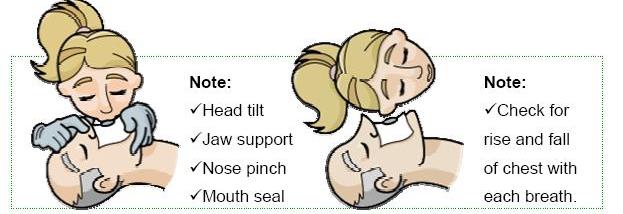 If breathing returns, turn the casualty into the recovery position, closely monitor their airway and breathing, ensure help is on the way, check for and treat other injuries.
If breathing returns, turn the casualty into the recovery position, closely monitor their airway and breathing, ensure help is on the way, check for and treat other injuries.An automated external defibrillator (AED) is a portable automatic device used to restore normal heart rhythm to patients in cardiac arrest. An automated external defibrillator is applied outside the body. The AED automatically analyses the casualty's heart rhythm and advises the first-aider whether or not a shock is needed to restore a normal heart beat. If the casualty's heart resumes beating normally, the heart has been successfully defibrillated.
The defibrillator is very simple to use. The first-aider simply follows the instructions. However, it is strongly recommended that you complete a short course on using a defibrillator so you are well prepared should you need to use it.
A casualty who is not breathing requires immediate and effective breaths. The different ways that breaths can be administered are described below.
This is where the rescuer places a face mask over the casualty's mouth and nose and breathes into a one-way valve device. This is the most desirable way of delivering breaths as the mask protects the first aider from coming in to direct contact with the casualty's body fluids and exhaled breath.
This is where the rescuer pinches or seals off the casualty's nose, gains a seal around the casualty's mouth with their lips and breathes directly into the casualty's mouth.
This is where the rescuer seals off the casualty's mouth by pressing the chin upwards and breathes directly into the casualty's nose. This method is used when the casualty has injuries or traces of poison around the mouth that rule out the use of the mouth-to-mouth technique. This method can also be used in deep water resuscitation.
This is where the rescuer places the lips around the entire mouth and nose area and breathes into the casualty's mouth and nose simultaneously. This method is preferred when delivering breaths to infants.
This method is used for a casualty who has an artificial opening and/or airway device in their throat. This artificial opening is known as a stoma and the rescuer needs to deliver breaths directly into the artificial airway or stoma while holding the casualty's mouth closed.
DRSABCD and call 000 (or 112 digital mobile phone).
After assessing and clearing the airway and determining that the casualty is not breathing:
If the casualty vomits during whilst giving breaths, quickly turn the casualty into the recovery position, clear the airway, reassess breathing and if there is no breathing, turn the casualty onto their back and recommence breaths.
 If breathing returns, turn the casualty into the recovery position, closely monitor their airway and breathing, ensure help is on the way, check for and treat other injuries.
If breathing returns, turn the casualty into the recovery position, closely monitor their airway and breathing, ensure help is on the way, check for and treat other injuries.